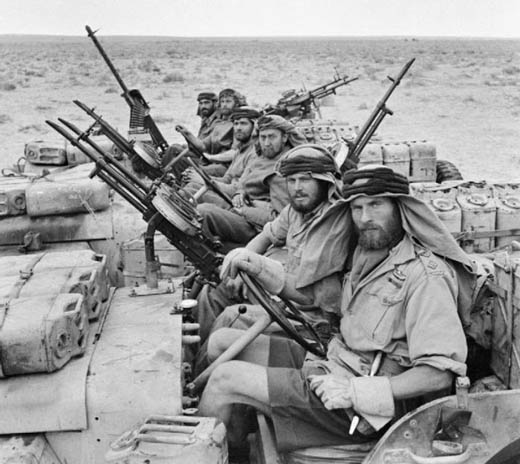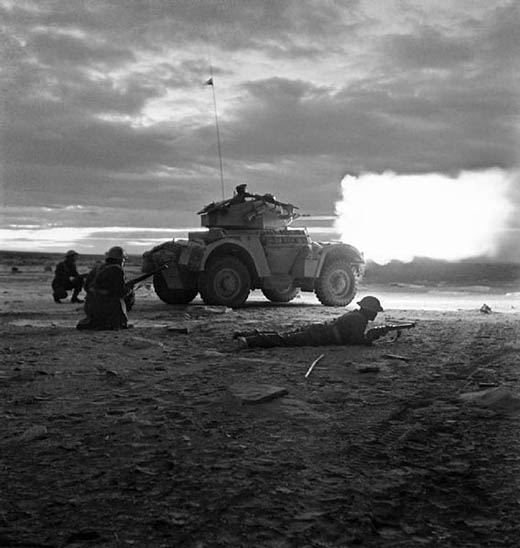Air Operations, Aleutians
Responding to a positive reconnaissance report, 4 28th Composite Bomb Group B-24s, 1 B-25, 4 B-26s, and 6 343rd Fighter Group P-38s depart Adak to attack 2 ships at Kiska. 2 B-26s abort with mechanical problems, and no hits are scored during the attack. While returning in bad weather, 2 B-24s vanish without a trace, 1 crash-lands at sea with its crew being rescued later, and the last B-24 crashes into 2 P-38s while landing, with the result that all 3 aircraft are lost.
[Air Operations, Bismarcks
90th Heavy Bomb Group B-24s mount single-plane attacks against the Gasmata airfield on New Britain and a cargo ship at sea.
[Air Operations, CBI
BURMA- 1 341st Medium Bomb Group B-25 and 8 51st Fighter Group P-40s attack Kamaing.
Air Operations, Europe
BOMBER COMMANDDaylight Ops:
- 21 Venturas and 14 Bostons are sent to Caen and Cherbourg, but are recalled because of unfavorable weather conditions.
- 22 Stirlings and 7 Wellingtons of No. 3 Group lay mines in the Frisians without a loss.
Air Operations, Libya
- XII Bomber Command B-17s attack the Tripoli/Castel Beniro Airdrome, and IX Bomber Command B-24s attack Tripoli harbor. In an engagement with Luftwaffe fighters, 1st Fighter Group P-38 pilots down 3 Bf-109s and damage as many as 9 more.
- During the night, 0 12th Medium Bomb Group B-24s join RAF light bombers in an attack against Axis aircraft concentrated at Castel Benito Airdrome.
Air Operations, Mediterranean
XII Bomber Command B-26a attack 2 Axis vessels in the Gulf of Hammamet.
[Air Operations, New Guinea
- V Bomber Command B-25s attack dumps and a motor pool at Lae
- 90th Heavy Bomb Group B-24s mount single-plane attacks against the Malahang airfield at Lae and Madang.
Air Operations, Solomons
- XIII Bomber Command B-17s and 347th Fighter Group P-38s and P-40s attack the Ballale airfield and shipping in the Shortland Islands. 2 347th Fighter Group P-40s down 2 A6M2-N 'Rufe' fighter-bombers over the Shortland Islands. 1 P-40 is lost.
Aleutians
2 American cruisers and 4 destroyers bombard Attu Island.
[Burma
The 47th Indian Bde of the 14th Indian Div attack the Japanese positions at Donbaik in the Arakan without success. The 123rd Bde is still dug in near Rathedaung, but is threatened by the enemy from the east, by an offensive thrust in the Kaladan valley.
[Eastern Front
After 7 days of intense fighting the Russians of the Leningrad and Volkhov Fronts succeed in clearing the supply corridor into Leningrad by the recapture of Schüsselburg and Sinyavino. The strip of ground is 10 miles wide south of Lake Ladoga. Leningrad, cut off since the autumn of 1941, can at last receive more supplies, German gunners permitting although trains are shelled repeatedly in the 'Corridor of Death'.
Soldiers From Two Fronts Meet |
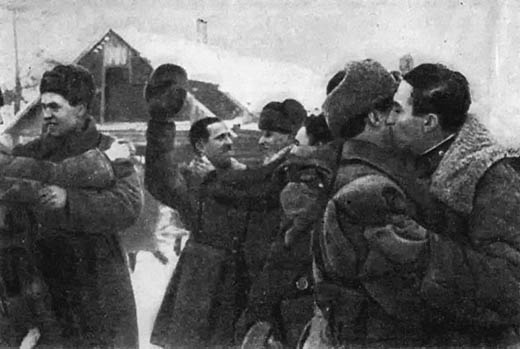 |
In the Caucasus von Kleist's Army Group A is resisting the powerful pressure by the Russians to avoid being cut off south of the Sea of Azov, while as many divisions as possible are withdrawn across the Rostov corridor, which is still open. The defensive line extends along the Kuban and Manyon Rivers and, in the north, along the lower Donetz. The Russians recapture Cherkessk and Divnoye along the Manych, 70 miles east of Elista.
NORTHERN SECTORSchlusselburg if recaptured by the Soviet 2nd Shock and 67th Armies. With a narrow corridor created through German lines south of Lake Ladoga, Leningrad can now be supplied.
SOUTHERN SECTORAs the Soviet 3rd Tank and 40th Armies line up at Alexievka, 3 Hungarian corps and the Italian Alpine Corps are encircled. Gumrak airfield is now under Red Army attack.[MORE]
[Guadalcanal
The Americans gain a continuous line from Hill 53 northward to the coast at a point some 1,500 yards west of Point Cruz. The double envelopment attack begins. I Company, 182nd Infantry, advances 450 yards south from Hill 42 to make contact about 1700 with a platoon detached from G Company which has advanced northwest from Hill 27 through the ravine. While these 2 units are advancing, E Company, which has followed I Company of the 182nd off Hill 42, swings to the left (east) to strike the Gifu from the west. The company knocks out 3 or 4 machine guns and kills 7 Japanese before halted by more machine guns. To the right of E Company, a platoon from G Company locates 2 pillboxes, calls in 81-mm mortar fire which knocks out 1.
The CAM Div continues westward on the northern flank of the XIV Corps with the 6th Marines on the right and the 182nd Infantry on the left. In the 25th Div sector, the 2nd Battalion, 35th Infantry, throws a tight cordon around the Gifu and begins an attack on it from the northwest.
[New Guinea
The Japanese in the Sanananda sector, though they know they will be defeated, hold out to the bitter end. They contest every yard of ground with the Australians both at Sanananda and at Giruwa. The US 163rd Infantry attacks a strongly fortified enemy position straddling the Soputa-Sanananda road north of Fisk. The 127th Infantry, with Companies G and F in the lead, continues westward along the coast against weakening resistance and gains 300 yards.
[North Africa
LIBYAThe British 8th Army continues to pursue the enemy toward Tripoli, but loses contact because of the terrain and obstacles. Gen Montgomery orders the pursuit accelerated and continued day and night.
|
|
The new Mark VI Tiger tanks are used for the first time in this theater as the Germans and Italians attempt to capture Bou Arada Hill and Robaa Hills, near Medjez. Neither the British nor the Americans have anything which can face them on equal terms. Col-Gen Jürgen von Arnim assumes command of Axis forces in Tunisia and opens an offensive to restore the Tunis bridgehead line by recovering ground lost to the French the night of Jan 12th and then seizing control of the passes west of Kairouan.
On the British 1st Army front, the 6th Armored Div, V Corps, contains a tank-infantry thrust down Bou Arada Valley at the junction of the French and British sectors. The main enemy attack forces the French XIX Corps back on the northern flank and reaches the road leading southwest to Rebaa Oulad Yahia.
Reviewing the Troops |
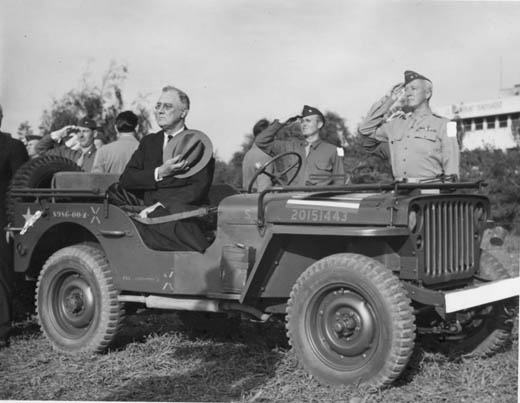 |
Occupied Poland
Armed resistance takes place for the first time in the Warsaw ghetto. The Jews begin to fight back with the resumption of deportations, which had been suspended since October 1942 and which they now realize means certain death.
Jews Killed During Uprising |
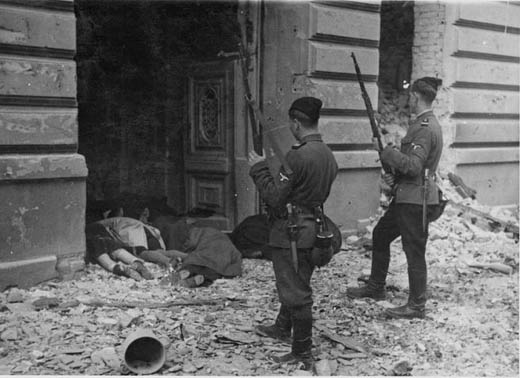 |
Pacific
- The US submarine Silversides (SS-236) sinks the Japanese fleet tanker Genyo Maru (10,018t) about 90 miles southwest of Truk, but is damaged by depth charges from an escorting warship and is forced to terminate her patrol.
- The US tanker Mobilube (10,222t) is torpedoed by the Japanese submarine I-21 off the coast of New South Wales, Australia with the loss of 3 crewmen. The Mobilube is towed to Sydney by the salvage tug St. Aristell, but is eventually decalred a total loss.
Soviet Union, Armed Forces
Notwithstanding the failure of MARS, Zhukov is promoted to Marshal of the Soviet Union and Deputy Supreme Commander of the Soviet Armed Forces. Considering the losses incurred during what was his brainchild, his promotion is perhaps somewhat surprising. MARS cost the Red Army nearly 500,000 yroops killed, wounded or captured (German casualties were around 40,000). The 20th Army lost 58,524 troops out of the original strength of more than 114,00. The I Mechanized Corps lost 8,100 of its 12,000 troops and all of its 220 tanks, and the accompanying VI Stalin Rifle Corps lost more than 20,000 of its 30,000 men. At lower levels the cost was even higher. Red Army tank losses during the operation amounted to 1,700.
[Soviet Union, Home Front
Moscow announces that the 900-day-long siege of Leningrad has been lifted. A corridor 10 miles wide is open south of Lake Ladoga. Leningrad's population is now dying at a rate of 20,000 a day. Had the city not been relieved, the rest of the winter would have been cataclysmic beyond imagination.
[